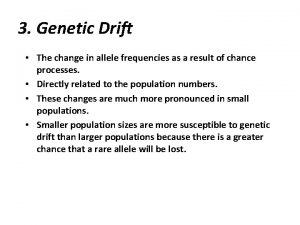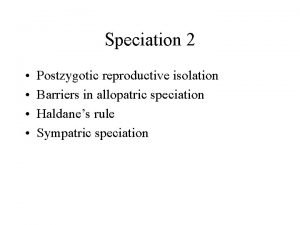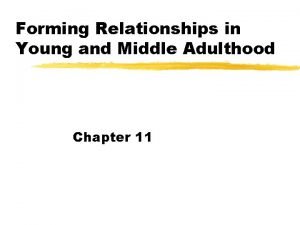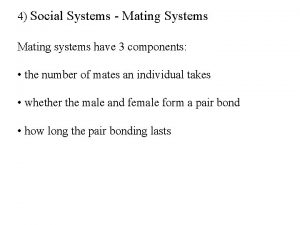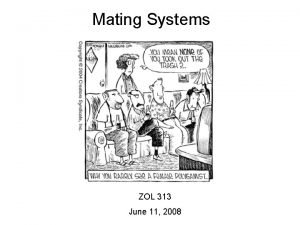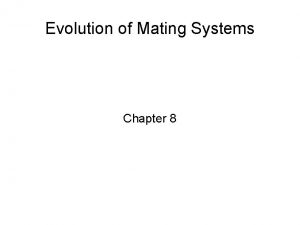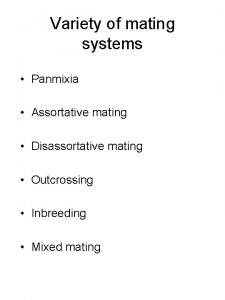Mating Systems Psychology 3107 Introduction For the most













- Slides: 13

Mating Systems Psychology 3107

Introduction For the most part, males’ involvement in mating, well, ends after the mating Females pay for the mating a lot more n n Physiologically Post birth/hatch care Therefore, we should expect Polygyny where males have more than one mate n Male variance > female variance

Polygyny There are several theories about polygyny Resource defense polygyny n Male defends some good resource Example, hummingbirds The resource is some nectar giving flower

Hummingbirds Male sets up territory Excludes other males Basically, the male exchanges letting females feed in exchange for copulations Sort of like nuptial gifts in some sinsects, but the ‘gift’ is stationary Females then set up breeding territory withing male’s teritorry

Polygyny Threshold Polygyny may occur when the ‘polygyny threshold’ is crossed Example here is migratory songbirds n n Males arrive, set up territories Females choose mates

Polygyny Threshold When differences in qualities of available territories crosses the polygyny threshold, then polygyny results n It is more profitable for the female to become a secondary female with a high end male, then a primary femle with a mid range

What about monogamy Monogamy should happen if: n n Curves are far apart Curves are flat In other words, little variation in quality of males and their territories Verner and Wilson did a really cool study that looked at these ideas

Verner and Wilson Marsh birds n Quality varies greatly vs Non Marsh birds n Not so much variation Prediction is that there should be much more monogamy in non marsh living songbirds

So, what happened Marsh species 44 % are polygynous Non Marsh 2 % are polygynous You can also get female defense polygyny n n Males basically guard the females Good example here is in Bison

But you said we’d talk about monogamy… OK, OK…… When should mongamy happen? n n n When the young are in need of lots of parental care When Territories or resources are poor When females actually enforce it! Some ‘monogamous’ species aren’t…. .

Extra Pair Copulations Happens a lot in birds Ummm, happens a lot in people ‘sperm competition’ n n Usually when female is unguarded or when male can get away with it…. . Sperm Wars

Polyandry One female, many males Exceedingly rare Usually only happens when there is complete sex role reversal n n Sea horses Spotted sandpipers

Conclusions Many theories as to why different animals have different mating systems Polygyny is by far the most common When you think about it, the system correlates nicely with the gametes!
 Non random mating
Non random mating Assortative mating
Assortative mating Assortative mating
Assortative mating Canine mating cont
Canine mating cont Fspos vägledning för kontinuitetshantering
Fspos vägledning för kontinuitetshantering Typiska novell drag
Typiska novell drag Tack för att ni lyssnade bild
Tack för att ni lyssnade bild Vad står k.r.å.k.a.n för
Vad står k.r.å.k.a.n för Shingelfrisyren
Shingelfrisyren En lathund för arbete med kontinuitetshantering
En lathund för arbete med kontinuitetshantering Adressändring ideell förening
Adressändring ideell förening Tidböcker
Tidböcker Sura för anatom
Sura för anatom Förklara densitet för barn
Förklara densitet för barn
